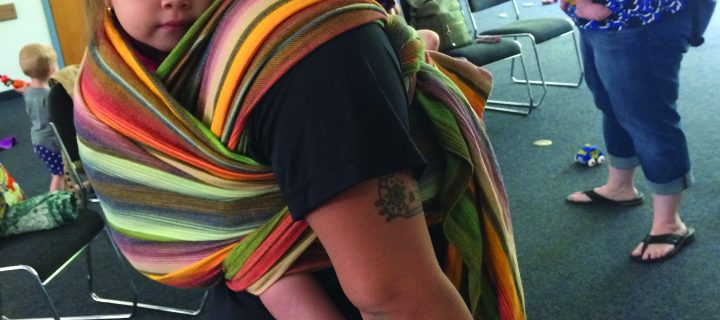Throughout centuries and across cultures, babywearing has been a valuable child rearing tool. Whether it is an African woman with baby secured in a Kente cloth, an indigenous Mexican with a baby on her hip in a Rebozo, or a Hmong with a baby snug in an ornate Dai Nyia, these caregivers all understand the special bond that comes from wearing their babies.
Thanks to a boom in the popularity and availability of baby carriers, we can add to that list the many Chicoans found about town with their child tucked into one of the many varieties of modern carriers.
Babywearing fell out of practice in western cultures during the Victorian era when baby carriages were introduced and cultural norms of child rearing changed. However, the practice re-emerged in the 1970s as western caregivers learned of its many benefits and, in recent years, the industry has seen a proliferation of variety in the types of carriers available.
Jenni’s Story
“Babywearing saved me,” first-time-mom, Jenni Harrington-Stoddard says. A new mom in a new city with zero support, Stoddard found herself struggling with a postpartum mood disorder that manifested as bursts rage. When she felt herself losing control, she would put her son on her back in a woven wrap. There, he was safe from what she calls, “the mommy monster.” Wrapped to her back, he had the sense of security she was struggling to provide and she was free to take a breather and attend to her own needs. Going to babywearing meet ups, where caregivers learn how to use different types of carriers and socialize, helped get her out of the house and introduced her to the support network she was lacking. At two, her son was diagnosed with Autism Spectrum Disorder and babywearing took on yet another benefit: whether it is the sensory experience of having fabric tightened around him, or knowing that he is not going anywhere, Stoddard said, wrapping makes him “just melt into me.”
Benefits for Children and Caretakers
Babywearing advocates say babywearing meets a primal need for human touch. It is also thought to provide a boost of oxytocin. Often dubbed the love hormone, oxytocin helps facilitate bonding.
Benefits
Wearing a baby for three hours a day has been found to reduce overall crying by 43 percent and evening crying by 54 percent.
With less crying, babies spend more time being alert, which along with experiencing the world from the same vantage point of the caregiver, is thought to aid in optimal development.
Caregivers that “babywear” report higher levels of confidence in their parenting abilities.
Contact between mother and child helps facilitate breastfeeding.
Babywearing does not have to end with babies. It is a great way to keep track of a busy toddler in crowded spaces and it offers a way for caregivers to connect with a child busy testing out new-found independence.
Here to Help
While babywearing is centuries old practice, for many caregivers, the task of finding the right carrier can feel daunting. Not to mention safety concerns.
Babywearing International of Chico, a volunteer-run nonprofit, offers educational support in Butte and Glenn counties. Accredited Volunteer Babywearing Educators hold regular meetings where caregivers can learn how to properly use carriers. It also maintains a library of carriers for demonstration and to loan out to interested caregivers.
When it comes to baby carriers, there is no one-size fits all. The type of carrier, brand, model and the anatomy of the wearer and their child, will change how a carrier fits. The library allows a caregiver to find what works for them, ensuring caregivers and children get to reap all the benefits of babywearing.
When the organization formed, its leaders knew one of its top priorities would be making sure all caregivers had access to those benefits. With that sentiment, they have provided educational support at the Torres Shelter and offer classes in low-income communities in Glenn County.
Safety First
At the forefront of BWI Chico’s work, is making sure carriers are being used correctly so children are safe:
A baby’s airway must never be restricted. This means making sure their face is always exposed and that they do not slump forward, causing their chin to push into their chest, cutting off their airway.
Babies should be in view and properly supported at all times. A caregiver should be able to kiss the top of their child’s head. This is called the “close enough to kiss” rule.
The safest positioning for a baby is upright with even support and their bottom and legs, forming an “M” position.
A child should only be placed in an outward facing carrier when they have good head and neck control, usually around 4 to 6 months. Watch for signs of over stimulation and if the child falls asleep, they should be turned around immediately.
Caregivers should keep in mind the extra layer of fabric a carrier provides and dress their child accordingly, to avoid overheating.
By Simona Gallegos
To find out more about BWI Chico’s meetings and events; visit www.Facebook.com/groups/BWIChico. If you think you may be struggling with a postpartum mood disorder, you can call 211 in Butte County to be directed to local resources.






